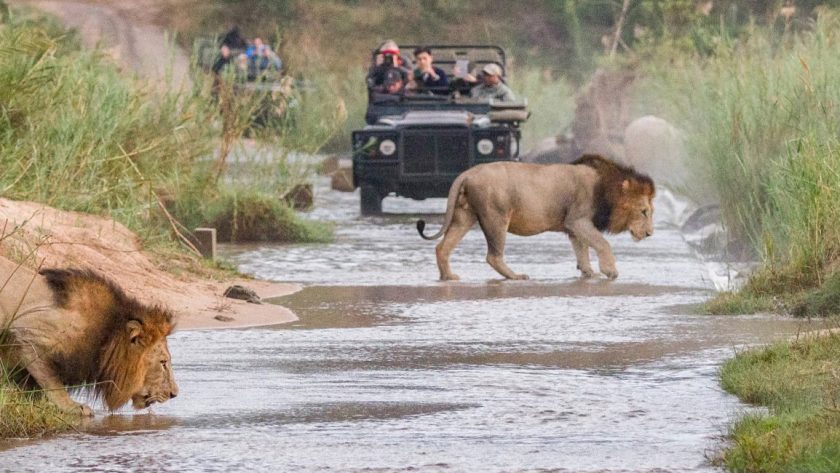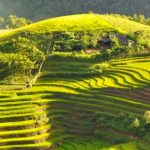Three miles from camp and a million miles from home, we come upon a footprint the size of a tire. My heartbeat quickens, and my pace follows. But Ian Milne, our instructor and longtime Kruger Park ranger, holds up a cautioning hand. It’s a stark reminder: class is in session. And it’s dangerous out here.
We’re in the heart of South Africa’s Klaserie Game Reserve, nestled along the unfenced northwestern frontier of Kruger National Park. Seven people – four South Africans and three Americans – are training to become the next field guides and game rangers in the SA national parks and reserves system. Ian leads our motley group, pointing out felled trees and enormous green spoor indicating the game we’re tracking: a family of elephants. The bright W.W.J.D. band on his wrist is a dramatic contrast with his subdued olive-and-khaki clothes and the loaded rifle in his hands.
Spotting the elephants in the bush, on foot, with no fences or Land Rover to protect us, has a high sphincter factor. I get chills, the good kind, as we creep closer. They’ve known about us much longer than we’ve known about them, and for now they’re tolerating the intrusion. So we watch, and wait. An hour passes as we slowly move closer – close enough to make out the brown bristles on the tops of their heads. It’s the most exhilarating thing I’ve ever experienced, but I can’t help but think back to a passage from the course manual, read in the safe confines of our classroom – The only way to stop a large animal in a serious charge is with a brain shot, or possibly severing the spine, Ian has written in his typical dry and sensible tone. But I would not recommend trying that.
The Field Guides Association of Southern Africa is the official sanctioning body for all field/safari guides working in South Africa. Completion of an FGASA-certified field guide course combined with the requisite bush experience enables aspiring Hemingways to work in what is arguably the world’s most exotic industry. The mere thought of training as a safari/field guide is intoxicating – the kind of adventure after which there is no encore.
Ian is just what you’d expect a guide training instructor to be: sun-glazed face, stern jawbones usually punctuated with a smile, laid-back demeanor, dry British sense of humor – and an innate upbeat attitude toward his country and its wild places. There are still Hollywood caricatures to be found in the field guide ranks – indeed, even in our class – but most of the program’s participants are normal Africans trying to keep pace with South Africa’s tourism boom. Ecotourism has been billed as the golden goose, a potential economic savior for a troubled place.
It’s true that in Africa, so much of the wildlife saga happens away from the wilderness. But here, with the elephants just 15 yards from where we stand, it’s impossible not to be mesmerized. They trumpet periodically, just to remind us who’s in charge. I step back from the fray, soaking in the moment. Each of my classmates is appreciating this in a different manner. The Americans absorb through gadgets – Houstonian Hal with his digital camera and Pittsburgher Jim with his binoculars. Alan, a measured Pretorian and passionate birder, watches through his own pair of high-powered Swarovskis. Karl, a South African by way of Berlin, is extraordinarily relaxed (I’d later learn that he’d been attacked by a lion years ago, so herbivores didn’t exactly phase him). Sandro, a boisterous game-hunting German who dreams of opening his own farm, looks like he’s imagining the bull elephant as a trophy on his wall. Gertrude, a quiet Zulu woman who brought nothing but open-toed shoes to the bush and who wasn’t expected to survive the strenuous hikes, makes the least noise of the whole bunch. It’s even more striking when I remember that black South Africans weren’t even allowed into Kruger and the reserves until the latter half of the twentieth century. For them the wildlife experience is as new and invigorating as it is to the Americans.
We watch the elephants for almost two hours – eating, communicating and playing. After a while I develop an almost-comfortable familiarity with them. And then we get too close. Our subtly shrinking perimeter vanishes as they trumpet and lope away. In the bottom of my dusty boots I can feel it. Their retreat may be the most impressive thing of all: Imagine an 18-wheeler moving with the agility of a figure skater. My mouth is dry. Ian sums up the moment perfectly: “That was special.”
Search and compare tours to Africa
The Dark Continent’s romantic past, when the super-rich were ferried through the countryside insulated from the realities of African life, is vanishing. The future looks more like South Africa, a growing population with better environmental awareness, shrinking wilderness and shrinking resources. That, and not the proper method for tracking elephants, is the ultimate lesson of Ian Milne’s course: for better or for worse, South Africa’s parks will set the example that the rest of Africa will follow. And if the dramatic spectacle of face-to-face contact with thundering elephants is any indication, that future looks hopeful.



